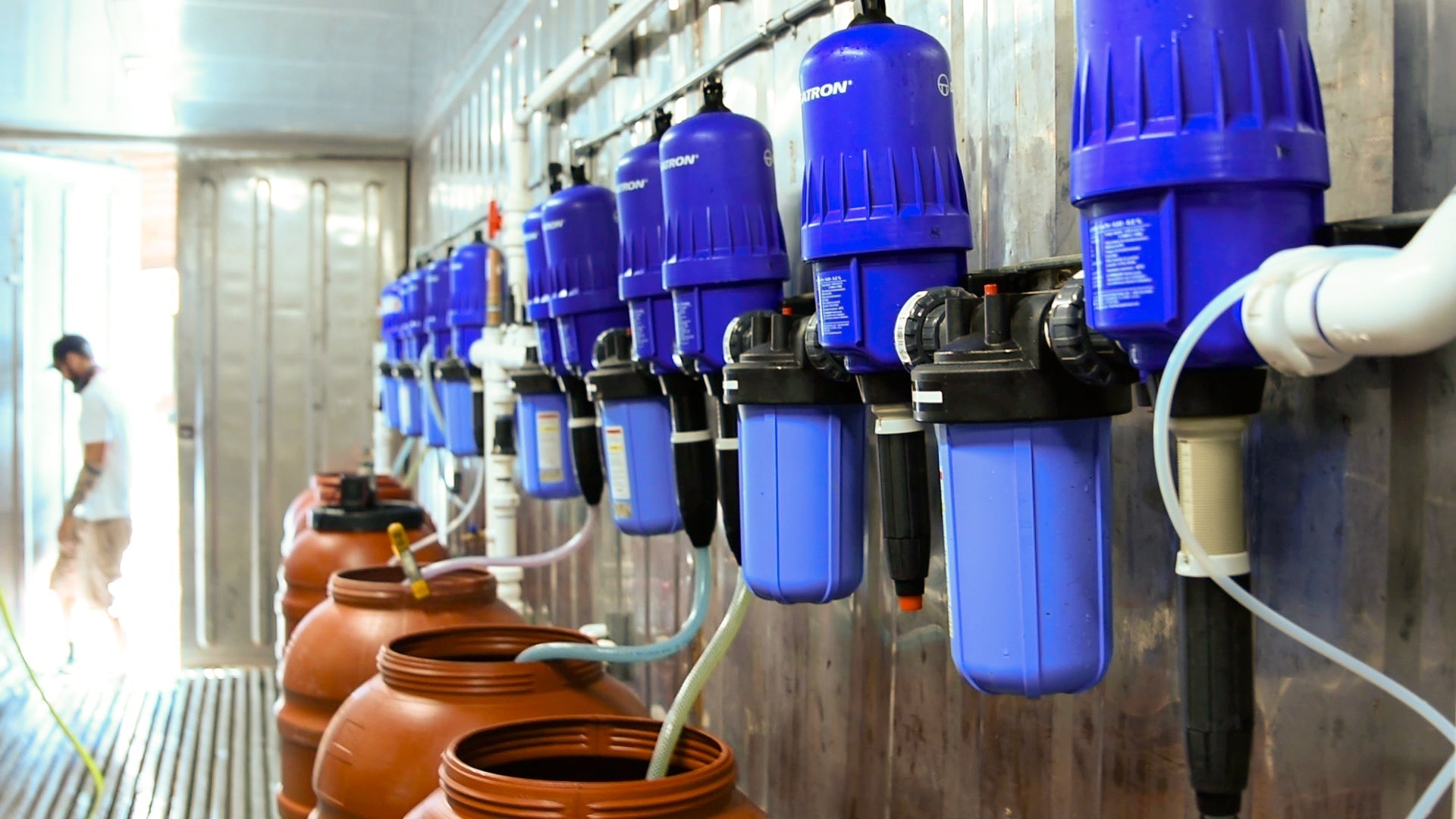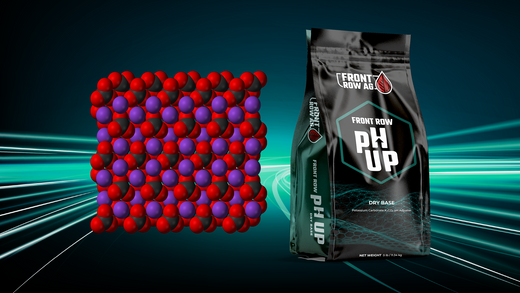Precipitation in hydroponic solutions can lead to reduced nutrient availability, clogged emitters, and compromised plant health. Below is a three-part guide focusing on the causes, manifestations, and troubleshooting steps for precipitation.
Part 1: Factors Influencing Precipitation
Precipitation arises when dissolved nutrients form insoluble compounds. Several factors can drive this process:
1. pH Fluctuations and Buffer Chemistry
The pH range of 5.5–6.0 typically minimizes precipitation for most nutrient formulas. However, even within this range, sudden pH spikes (or dips) can cause certain minerals to fall out of solution.
pH Ranges and Risks:
- High pH (>6.2): As pH drifts above this range, there are escalating risks for precipitation of:
- Calcium phosphate (primary concern due to high Ca²⁺ and PO₄³⁻ concentrations)
- Magnesium phosphate (secondary but still significant)
- Metal hydroxides and phosphates (particularly iron, zinc, and manganese)
- Calcium carbonate (in hard water with high bicarbonate levels)
- Calcium Sulfate (Gypsum) (high Ca + high sulfur)
- Low pH (<5.0): Increases solubility of most nutrient salts, potentially leading to excessive availability of some minerals, especially micronutrients. Can destabilize chelated nutrients and nutrient complexes.
- Rapid swings: Allow insufficient time for fertilizers to equilibrate, increasing local supersaturation and micro-precipitation
Buffer Chemistry and pH Stability:
- Buffer capacity refers to a solution's ability to resist pH changes when acids or bases are added
- Carbonate/bicarbonate systems are the primary buffer in most hydroponic solutions
- Soft bases like potassium carbonate (K₂CO₃) found in Front Row pH Up are preferred over strong bases like potassium hydroxide (KOH) because:
- They contribute to buffer capacity rather than merely adjusting pH
- They create fewer localized high-pH zones that can trigger precipitation
- They provide more stable, longer-lasting pH adjustment
- KOH application without sufficient dilution is a common cause of precipitation.
- pH up should always be added last in the mixing sequence because:
- This prevents temporary pH extremes during the mixing process
- It allows proper dissolution of all nutrients before final pH adjustment
- It reduces the risk of localized precipitation during mixing
2. Water Quality and Chemistry
Water quality parameters interact in complex ways to influence precipitation risk in hydroponic systems. Beyond simple mineral content, the oxidation state of the solution, dissolved gas levels, and various ionic equilibria all play crucial roles in maintaining nutrient stability. These parameters can shift throughout the day due to plant activity, microbial processes, and environmental factors, creating dynamic conditions that affect nutrient availability. Understanding these interactions helps growers anticipate and prevent precipitation events before they occur.
Oxidation-Reduction Potential (ORP):
- ORP measures the oxidizing or reducing power of the solution
- High ORP (>500mV) can indicate:
- Excessive levels of oxidizers like hydrogen peroxide or chlorine
- Risk of metal oxidation and precipitation
- Potential degradation of chelated nutrients
- Ideal ORP is 300-400mV at the dripper
- Oxidizers can react with micronutrients to form insoluble oxides and hydroxides
- Hydrogen peroxide particularly affects iron and manganese availability and is a common cause of turbidity
Dissolved Oxygen (DO):
- DO levels affect nutrient solubility and microbial activity
- High DO (risk slowly increases >8 ppm) can:
- Promote oxidation of iron from Fe²⁺ to less soluble Fe³⁺
- Increase precipitation risk of certain metal hydroxides
- Support beneficial aerobic bacteria that may influence precipitation
- Low DO (<4 ppm) can:
- Lead to reducing conditions that may solubilize some precipitates
- Promote anaerobic bacteria that produce organic acids
Hard Water Considerations:
- High calcium and magnesium levels in source water increase precipitation risk
- Carbonate hardness (KH) affects buffer capacity and pH stability
- Hard water may require:
- Acidification
- Pre-treatment through reverse osmosis
- Adjusted nutrient formulations to account for mineral content
- More frequent monitoring of calcium and magnesium levels
3. Biological Activity and Water Sanitation
Biological activity from source water creates a environment that can significantly impact nutrient stability and precipitation patterns. Microorganisms, biofilms, and their metabolic processes can alter local chemical conditions, creating microsites where precipitation is more likely to occur. These biological factors interact with water chemistry in ways that can either promote or prevent precipitation, making proper sanitation and biological management crucial for maintaining stable nutrient solutions.
Microbial Influences on Precipitation:
- Biofilms can:
- Create localized pH changes that trigger precipitation
- Bind nutrients and create nucleation sites for crystal formation
- Release compounds that complex with nutrients
- Dislodge and cause clogs in filters/emitters
- Bacterial metabolism can:
- Alter local pH conditions
- Produce organic acids that affect nutrient solubility
- Generate compounds that bind with nutrients
Common Sanitation-Related Precipitation Triggers:
- Insufficient system cleaning leading to biofilm accumulation
- Poor filtration allowing organic matter to accumulate
- Inadequate sanitizer levels permitting microbial growth
- Temperature fluctuations promoting microbial activity
- Dead zones in plumbing where biomass can accumulate
Prevention Through Sanitation:
- Regular system cleaning and sanitization
- Proper water filtration (mechanical and biological)
- Maintaining appropriate sanitizer levels e.g. use calcium hypochlorite to achieve ~2ppm free chlorine at the dripper
- Managing water temperature
4. Mixing Sequence and Concentration
The order in which you introduce fertilizer components can make a major difference in solubility. Highly concentrated stock solutions or simultaneous mixing of incompatible fertilizers (e.g., high-calcium and high-phosphate solutions) can precipitate salts.
Stock Solution Considerations:
- Concentrated stock solutions: Create zones of high ionic strength where calcium phosphate or calcium sulfate can form quickly
- Incorrect mixing sequence: If calcium nitrate concentrate contacts a phosphate solution before adequate dilution and mixing time, Ca₃(PO₄)₂ (calcium phosphate) may precipitate
Best Practices for Mixing:
- Always dilute concentrated solutions before combining
- Always incorporate a mixing chamber or adequate distance between injectors of calcium (Part A) and phosphate/sulfate (Part B and Bloom)
- Maintain constant agitation during mixing
- Monitor temperature during mixing process
5. Water Temperature
Temperature affects nutrient solubility, but its impact is often secondary to other factors like pH, concentration, and ionic interactions. Understanding temperature's role helps maintain stable solutions.
Temperature Effects on Nutrient Solubility:
- Calcium Phosphate:
- Precipitation primarily driven by pH, especially above 6.0
- Temperature is a secondary factor to pH and concentration
- Risk increases when combined with elevated pH and high phosphate levels
- Calcium Sulfate:
- Sensitive to high concentrations of S and Ca in combination with low temperatures
System Temperature Management:
- Optimal Range: 68-72°F (20-22°C)
- Primarily for root health and nutrient uptake
- Helps maintain stable dissolved oxygen levels
- Generally supports consistent nutrient availability
- Temperature Considerations:
- Moderate changes (60-68°F) rarely cause precipitation alone
- Lower temperatures may compound existing instability
- Multiple factors (pH, concentration, mixing) typically drive precipitation
- Most significant impact is on plant metabolism and oxygen solubility
Best Practices:
- Monitor both source water, nutrient solution, and ambient temperatures
- Be aware of seasonal drops in temperature that can initiate precipitation “out of nowhere”
- Focus on maintaining stable conditions rather than exact temperatures
- Address pH and concentration issues before attributing problems to temperature
- Consider temperature effects alongside other system parameters
- If necessary in winter, heat water prior to mixing nutrient solutions
6. Ionic Interactions
Certain ions naturally have low solubility pairs. Calcium, magnesium, and phosphate are prime culprits; iron and phosphate also have a strong affinity.
Common Problematic Pairs:
- Calcium + Sulfate/Phosphate: Calcium sulfate is moderately soluble at typical hydroponic concentrations, but localized high calcium plus sulfate or phosphate can cause precipitation
- Magnesium + Phosphate: Under certain pH conditions, magnesium phosphate salts may form, though they are less common than calcium phosphate
- Iron + Phosphate: Forms particularly stable precipitates, especially at higher pH
7. Contaminants and Impurities
If your source water is high in bicarbonates or silica, or if there are trace metals or organic materials, these can seed or catalyze precipitation. Even small amounts of biofilm can bind with nutrients, further complicating precipitation in lines or on reservoir surfaces.
Part 2: Common Precipitates
Most precipitates in hydroponic systems manifest as scale-like buildup or cloudy flakes suspended in solution or adhered to surfaces. Below are the most frequently seen types:
1. Calcium Phosphate (Ca₃(PO₄)₂)
- Appearance: A fine, whitish precipitate that often coats the bottoms of tanks or the interiors of pipes
- Contributing Factors: High calcium and phosphate concentrations, typically precipitating when the pH drifts above 6.0 or from improper mixing
- Impact: Clogs emitters and drippers; reduces phosphate availability
2. Calcium Sulfate (CaSO₄)
- Appearance: Off-white or sometimes slightly yellowish crystal formations
- Contributing Factors: Occurs under conditions of high calcium and high sulfate when the solution cools or concentration spikes happen near a feed line
- Impact: Not as common as calcium phosphate in well-balanced systems, but can still reduce overall calcium or sulfate availability and coat surfaces
3. Iron Phosphate (FePO₄)
- Appearance: Reddish-brown or sometimes rust-colored flakes
- Contributing Factors: Formed when iron is provided in forms that become insoluble if the solution pH rises or if phosphate is extremely high
- Impact: Can cause iron deficiency in plants if it precipitates heavily, as the bioavailable iron is locked up
4. Magnesium Phosphate (Mg₃(PO₄)₂)
- Appearance: Typically a white to gray deposit, similar to calcium phosphate but can have a slightly denser texture
- Contributing Factors: Elevated magnesium and phosphate levels in the presence of near-neutral to slightly alkaline pH
- Impact: Can deprive plants of both magnesium and phosphate if deposits become significant
5. Silica Precipitates
- Appearance: A hard, glassy, often translucent to white scale. Can manifest as a thin, almost invisible film or a thicker, more substantial buildup resembling glass or porcelain. Initially, it may appear slightly gel-like or opalescent before hardening into a very durable, difficult-to-remove scale.
- Contributing Factors:
- High Silica Source Water: Source water naturally high in dissolved silica or silicates is the primary source. Well water and some surface water sources can contain significant levels.
- pH Fluctuations and Instability (Especially Increases & Localized Spikes): While silica solubility generally increases with very high pH (alkaline conditions), pH fluctuations and instability within the hydroponic range, particularly increases or localized spikes, can still contribute to silica precipitation over time. Even within the target pH range, disturbances can trigger the polymerization of dissolved silicic acid into less soluble forms. Localized high pH zones near pH up addition points are particularly problematic as they can initiate polymerization.
- Impact:
- Emitter and Dripper Clogging**:** Clogs emitters and drippers, leading to uneven nutrient delivery and plant stress.
- Hard Scale Buildup**:** Forms a very hard, tenacious scale on reservoir walls, pipes, pumps, and other system components. This scale can reduce system efficiency, restrict flow, and be very difficult to remove mechanically.
- Difficult to Remove with Standard Cleaners**:** Unlike calcium-based precipitates, silica scale is often resistant to acid cleaners. It typically requires alkaline cleaners or specialized silica removal products and often requires more aggressive mechanical cleaning methods.
6. Biofilm or Organic Precipitates
- Appearance: Slimy, darkish films that may trap other precipitates
- Contributing Factors: Usually develops with organic nutrient additives or if the system is not sanitized regularly
- Impact: While not always a mineral precipitate, biofilm can trigger additional precipitation by binding ionic nutrients to its surface
Part 3: Checklist for Solving Precipitation Problems
Use the following steps to troubleshoot and resolve precipitation issues:
1. Visually Identify the Precipitate
- Check color, texture, and location. A white scale at the bottom of the tank often suggests calcium phosphate, while rust-colored flakes point toward iron phosphate
- Once identified, focus on the specific nutrient interactions that create that precipitate
- Document the pattern and timing of precipitation occurrence
2. Evaluate Current pH and EC
- Record the actual pH and EC in the reservoir and at the dripper. Small, steady fluctuations are normal, but large deviations or persistent high values (pH >6.5, EC >4.0) can encourage precipitation
- Make gradual corrections to pH or EC to avoid precipitate "shock" events
- Ensure that you’re not over-applying pH up - there is some “lag time” with most pH up products taking 5-15 minutes to exert their full effects.
- Monitor buffer capacity by tracking pH stability over time
3. Check Mixing Procedures
- Review your order of operations. If you are mixing a calcium-based fertilizer and a phosphate-heavy component too close in sequence, consider adding additional mixing space in the fertigation line, or diluting them further.
- Use adequate agitation: Ensure the solution is well-mixed and evenly dispersed before adding the next component
- Verify proper dilution ratios for stock solutions
- Verify proper injection rates for dosers/fertigation systems
4. Assess Water Quality
- Test source water for:
- Alkalinity (bicarbonates)
- Calcium
- Magnesium
- Sulfates
- ORP
- Dissolved oxygen
- Fungal and Bacterial CFUs
- Other impurities e.g. silicates
- High bicarbonates can buffer pH upward, increasing precipitation risk
- If necessary, pre-treat or choose a different water source, especially if contamination or extreme hardness are persistent
5. Manage Temperature
- Keep reservoir temperatures in a moderate range (65–75°F / 18–24°C) to maintain consistent solubility
- Insulate or heat the reservoir (or source water) if cold temperatures are causing precipitation spikes
- Monitor temperature fluctuations and their correlation with precipitation events
6. Perform Preventive Maintenance
- Clean reservoir surfaces, lines, and emitters regularly to remove any early deposits or biofilms
- Consider flushing the system with a mild acid solution e.g. BioSafe Green Clean Acid or commercial line-cleaner to remove scale deposits
- Implement a regular sanitization schedule
7. Adjust or Replace Nutrient Formulas
- Use a fertilizer like Front Row Ag with high purity minerals, precise manufacturing, and stable chelated micronutrients.
- Employing a three-part nutrient system can give finer control over ionic interactions, especially when adjusting calcium and phosphate levels
Tip: When making any changes, log your adjustments to track what works. Document pH, EC, nutrient additions, and observations of any new precipitate. Over time, this data will help refine best practices for your unique system.
Final Thoughts
Keeping your hydroponic system free of precipitates requires attention to pH, ionic balance, water quality, temperature, sanitation, and appropriate mixing procedures. By understanding the chemistry behind common precipitates—like calcium phosphate, calcium sulfate, and iron phosphate—and following a systematic checklist to identify and resolve issues, you can maintain a cleaner, more efficient system and optimize nutrient availability for your crops.




